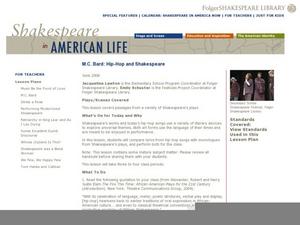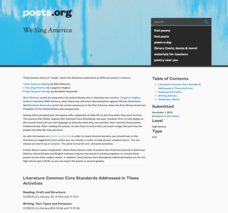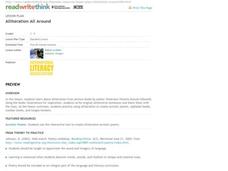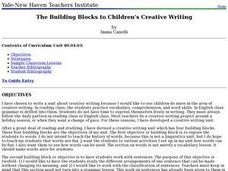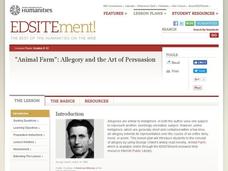Curated OER
Lesson: Paul Chan: Tree of Life
Paul Chan's work has been known to show the cycle of change. Learners explore the concept of change by analyzing his work and reading the poem "For Which it Stands." They consider symbolism, communication, art, and society as they use...
Curated OER
Go Free or Die
Groups of older elementary learners begin their study of figurative language by visiting a website and completing the exercises detailed there. They then apply what they have learned by finding examples in several poems. Finally, they...
Curated OER
M.C. Bard: Hip-Hop and Shakespeare
What is poetry? Does hip-hop qualify as poetry? Do Shakespeare's monologues qualify as poetry? Class members grapple with these questions as they examine the poetic elements and themes presented in different texts. Groups of four study...
Curated OER
From Light to Dark and Back
Experiment with light and dark in a series of interactive activities that lead up to reading and writing poetry. Class members have the opportunity to observe their feelings while sitting in the light and dark and to play with shadow...
Education Oasis
Creative Writing Unit: Analyzing, Interpreting, Discussing and Writing Various Genres of African-American Literature
A six-week unit takes high schoolers through various works of African-American literature, including poems, plays, and short stories. The lesson plan format includes a week-by-week description of activities, goals, materials, and...
Curated OER
Carl Sandburg's "Chicago": Bringing a Great City Alive
Students examine the historical and cultural context in Sandburg's poem. The poetic devices of personification and apostrophe are utilized in the poem and identified by Students.
Curated OER
Chinese Landscape Painting
Third graders learn about Chinese poetry and landscape paintings, then create their own. They view several examples and discuss the elements of each, then paint their own landscape inspired by what they saw. They then listen to, read,...
Academy of American Poets
We Sing America
Pair the famous poems "I Hear America Singing," by Walt Whitman, and "I, Too, Sing America," by Langston Hughes, with a more recent poem by Elizabeth Alexander called "Praise Song for the Day" to demonstrate a theme and introduce your...
ReadWriteThink
Alliteration All Around
Discover alliteration found in picture books by Pamela Duncan Edwards. Then, dive into a read aloud of Alligators All Around by Maurice Sendak. This practice sets the stage for budding poets to create their own acrostic poem, write an...
Curated OER
Playing Vocabulary Basketball
Learners view a slide show featuring famous athletes and educational institutions that have played a part in the history of basketball. They participate in a game in which a basketball is tossed from person to person as facts and...
EngageNY
Grade 11 ELA Module 1: Unit 1, Lesson 5
Scholars analyze words to determine the central idea of the poem My Last Duchess. Pupils begin by discussing homework and then form pairs to work through a list of questions about the poem. Finally, they complete a brief writing prompt...
National Endowment for the Humanities
The Poet's Voice: Langston Hughes and You
Middle schoolers complete a unit of lessons that explore the poetic voice of Langston Hughes. They define voice, read and analyze various poems by Langston Hughes, and complete journal entries for each instructional activity.
Indiana University
Asian Literature: “The View in Spring” by Du Fu
Over the course of the lesson plan, your pupils read and analyze a translated eight-line poem from the Tang Dynasty written by Du Fu, a poet caught behind enemy lines during the An Lu-Shan rebellion (755-763). Literary/historical context...
Curated OER
Rhythm and Rhyme
Youngsters listen to poetry and music to understand that words are made of sounds. In this rhythm and rhyme lesson, students create songbooks of healthy eating songs. They will also act out pantomimes and dance to the music. Each...
Curated OER
Friendship Cinquains
Learners discover that a cinquain is a simple five-line poem that follows a pattern. They interview a friend and use what they learn to write a cinquain about that person. As an added touch, each of the poems are written inside the shape...
Curated OER
Be the Poet
Students work through a Haiku Organizer to determine the characteristics they use to write eight haiku poems on a theme that they choose. They design presentation folders of their completed work.
Curated OER
Robert Frost
Young scholars view a PowerPoint presentation on Robert Frost. They discuss Robert Frost's life and poetry as they view the presentation. Following the presentation students answer five short answer questions about Robert Frost.
Newspaper in Education
The Iliad: A Young Reader Adventure
Is The Iliad part of your curriculum? Check out a resource that offers something for those new to teaching the classic and those with lots of experience using Homer's epic. Plot summaries, discussion questions, activities abound in this...
Curated OER
Creative Writing: Children's Building Blocks
Your class can participate in a writing program involving four building blocks. By exploring words, sentences, writing forms, and story organization, they improve their creative writing skills throughout this year-long unit. Early in the...
National Endowment for the Humanities
Animal Farm: Allegory and the Art of Persuasion
Introduce your class members to allegory and propaganda with a series of activities designed to accompany a study of George Orwell's Animal Farm. Readers examine the text as an allegory, consider the parallels to collective farms and the...
EngageNY
Considering a Character’s Relationship with Others: Contrasting Ha and Her Brothers
Who is Ha? Scholars look closely at the poem Papaya Tree and carefully examine the character Ha. Learners work in groups to create an anchor chart defining Ha's character. They also answer text-dependent questions to help with...
EngageNY
Development of the Plot: Impending Danger and Turmoil
Danger! Scholars look closely at two poems, 'TV News' and 'Closed Too Soon.' While reading, learners think about Ha's country's increasing dangers and conflict. They record their thoughts in graphic organizers and discuss what details...
EngageNY
Jigsaw to Analyze Mood and Tone in To Kill a Mockingbird (Chapter 8)
We have an appointment! Scholars meet with another discussion appointment to discuss the text structure of the poem "Incident" by Countee Cullen. They use a Note Catcher to guide their thinking and compare the structure to chapter 8 of...
EngageNY
Grade 11 ELA Module 1: Unit 1, Lesson 6
Get ready for the big reveal! Scholars work in the final instructional activity of the unit to discuss the revelation in Browning's poem My Last Duchess. Pupils discuss homework in pairs before working in small groups to identify text...




